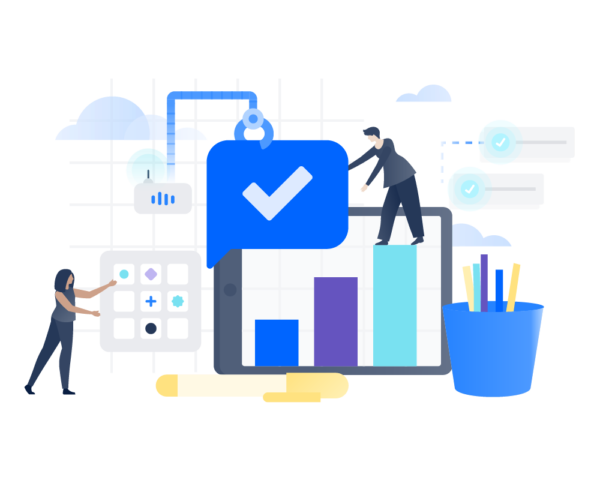Our cloud tools are getting even better in 2021
We’re working hard to improve cloud every day. Here’s what we have in store for the coming year.
In 2020, 95 percent of new Atlassian customers chose cloud, and in 2021, we expect that number to keep on growing. So we’re continuing to pour our research and development efforts into making cloud better every single day.
If you’re curious about the improvements we’re making now and those we’re planning for the future, our new, regularly updated cloud roadmap showcases everything we’re working on, from features we’re almost ready to launch to our biggest ideas for 2022 and beyond.
Here’s a peek at our 2021 plans:
We’re improving (and speeding up) remote collaboration
Time-to-value is still a top reason companies move to the cloud, so it should come as no surprise that it’s one of our highest priorities as we launch new features. 76 percent of Atlassian customers already say that speed on cloud is better than or equal to speed on server, according to a TechValidate survey of 300 Atlassian customers. But we’re perfectionists, so we haven’t stopped there.
What’s coming:
- Faster cloud tools: We’re improving the speed of the Jira Software experience; collaboration and page load times in Confluence; and the customer portal, inbound email, and queues in Jira Service Management. By the end of the year, our goal is for Jira and Confluence features to load 1.5 times faster.
- External collaboration for Confluence: The new external collaborator role will allow you to cooperate more easily with clients and contractors without compromising on security. External collaborators will only be able to access content and user information if admins explicitly grant permission.
We’re adding new features and tools to support all kinds of teams
Whatever type of team you’re on – ITSM, DevOps, agile, ITOps – we have your back. From new support tools to better UI, we’re focused on helping teams do their best work.
What’s coming:
- Conversational ticketing with Halp: Provide support; open, track, and close help desk tickets; and send customer satisfaction surveys, directly in Slack or Microsoft Teams. Halp integrates seamlessly with Jira Service Management, so you won’t have to duplicate ticketing efforts in order to provide real-time support in your chat platforms. Slack itself improved time to resolution on their help desk tickets by 50 percent when they implemented Halp.
- Issue linking for remote sites in Jira Service Management: Issue linking lets you create associations between issues. This means that if Issue B can only be resolved once Issue A is resolved, or if resolving Issue A will automatically resolve Issue B, you can tie them together in the system for easier tracking and resolution.
- A redesigned ticket view in Jira Service Management: Design your view screen according to your use cases and prioritize fields that are important to your users with a new ticket view, coming this year to Jira Service Management.
- An improved Mindville Insight integration with Jira Service Management: Mindville Insight already unlocks enterprise asset management in Jira, but now we’re making it even better. Teams will be able to search insights, incorporate them into automated workflows, and improve how they’re shown in the issue view.
- Bitbucket tool improvements: Build Windows apps using Bitbucket Pipelines, keep better track of progress by marking individual files as reviewed, and support repositories larger than 2GB.
- Streamlined views and workflows in Jira: A more streamlined change management workflow is on the way, as are custom filters designed to refine your view of backlogs and boards.
- Smarter sprint planning in Jira: Soon, Jira will automatically calculate and recommend sprint targets and improvements.
- More robust tool integrations: Connect Jira Service Management Cloud to your Jira or Confluence server or Data Center deployment with inbound traffic restrictions. This will bridge the gap between teams while also supporting a hybrid deployment.
We’re meeting the needs of large enterprises in cloud
Eighty percent of Fortune 500 companies have an Atlassian Cloud license, which means we’re adept at supporting large-scale businesses with thousands of users. This year, we’re lifting that ceiling with a 20,000-user program for Confluence and Jira. Early access is coming soon, and we’re planning to roll out those higher limits on a large scale later within the year.
We’re making admins’ lives a little easier (again)
We’re always looking for ways to make the lives of admins easier. Admins are, after all, foundational to their teams’ success. So in 2021, we’re rolling out lots of admin-focused innovations and improvements.
What’s coming:
- More detailed admin roles: Have multiple admins and need multiple permission sets? We got you. New, more granular admin roles will let you assign detailed permissions for billing, user management, product configuration, and more.
- Centralized permission views: See all user permissions in one central place in Jira, Jira Service Management, and Confluence. In Bitbucket, you’ll soon be able to apply changes to configuration and access lists in bulk.
- Organization-level user and group directories: We’re simplifying user setup by allowing you to use a single set of users and groups across multiple cloud instances for Jira, Confluence, Jira Service Management, and Bitbucket.
- Hybrid Bitbucket deployment: Enable hybrid deployment without opening up your firewall.
- Greater data control: The new Jira data lake will let you mix and match Jira data with data from other tools.
We’re continuing to invest in security and compliance
Security and compliance have a permanent spot at the top of our list, and we think our commitment shows. In fact, according to that same TechValidate survey, 92 percent of Atlassian customers say security and compliance are better or equal in the cloud (when compared to on-premise hosting).
These stats are not surprising. After all, 48 percent of developers say they don’t have time to devote to security issues, which means the simple act of moving to cloud – where we devote serious, dedicated resources to keeping systems safe – is likely to improve your peace of mind by a large margin.
What’s coming:
- Multiple identity providers: This update will allow you to sync users and groups from multiple identity providers into the same organization and apply SSO configurations.
- VPAT templates: For federal contractors pitching new projects, our new Voluntary Product Accessibility Templates (VPAT) will explain how our technology products adhere to Section 508 accessibility standards.
- Accessibility improvements: Atlassian products are built to align with Web Content Accessibility Guidelines 2.1 (WCAG) as closely as possible. In 2021, we’ll continue auditing and improving this accessibility.
- App security upgrades: Apps in Jira, Confluence, and Jira Service Management will be automatically scanned for top security vulnerabilities.
- User security improvements for Jira, Confluence, and Jira Service Management: Control mobile app use through MDM software. Track user activity through a new log system. And set minimum security requirements for users outside your organization (such as contractors or partners).
- Bitbucket security upgrades: Most Atlassian products already encrypt your data both in transit and at rest. This year, Bitbucket will join the fold. It already encrypts in transit, but soon it’ll also encrypt data at rest. And if you add an Atlassian Guard subscription, Bitbucket will support user provisioning from an external directory later this year.
- Data residency for apps: Top Jira, Confluence, and Jira Service Management applications will get a major upgrade in 2021, providing data residency in apps for companies subject to regulations.
We’re helping customers make the move to the cloud
Thinking of migrating from server to cloud? Migration is already easier than you think. In fact, 40 percent of customers who made the switch say the process was easier than expected, and 33 percent say the process was faster than anticipated. And 89 percent say they started reaping the benefits of cloud within six months of migrating (once again from a TechValidate survey of 300).
Even though we’re already getting great feedback on the migration process, we’re always looking for ways to make it even better; our list of 2021 migration improvements is an ambitious one.
What’s coming:
- Marketplace app migration: Use the migration assistant tools to migrate app data in Jira, Jira Service Management, and Confluence.
- Expanded capabilities for Confluence and Jira Migration Assistants: Our existing Confluence and Jira Migration Assistants are getting even better in 2021. Jira Migration Assistant will add advanced roadmap migration and cloud-to-cloud migration functionality. And Confluence Migration Assistant is expanding to include Team Calendars and Confluence Questions.
- Jira Service Management project migration: Migrate your Jira Service Management projects to cloud with new functionality in the Jira Cloud Migration Assistant.
- New Bitbucket cloud migration assistant: Automatically migrate projects, repositories, pull requests, users, groups, permissions, and LFS repositories from Bitbucket server or Data Center deployments to Bitbucket cloud.
In short, for 2021, our vision remains the same: make cloud the best place for our customers to land. We’re listening to your feedback, brainstorming solutions to common requests, and updating our roadmap as we go. We’re excited about what’s to come, and we hope you are too.
Want to keep up with all the improvements and new ideas on the horizon? Visit our cloud roadmap to see our plans for 2021 and beyond.





